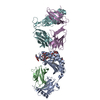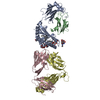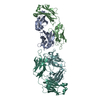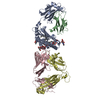[English] 日本語
 Yorodumi
Yorodumi- PDB-3rug: Crystal structure of Valpha10-Vbeta8.1 NKT TCR in complex with CD... -
+ Open data
Open data
- Basic information
Basic information
| Entry | Database: PDB / ID: 3rug | |||||||||
|---|---|---|---|---|---|---|---|---|---|---|
| Title | Crystal structure of Valpha10-Vbeta8.1 NKT TCR in complex with CD1d-alphaglucosylceramide (C20:2) | |||||||||
 Components Components |
| |||||||||
 Keywords Keywords |  IMMUNE SYSTEM / IMMUNE SYSTEM /  mouse CD1d / mouse NKT mouse CD1d / mouse NKT | |||||||||
| Function / homology |  Function and homology information Function and homology informationregulation of immature T cell proliferation in thymus / positive regulation of NK T cell differentiation / positive regulation of NK T cell activation / NK T cell differentiation / endogenous lipid antigen binding / exogenous lipid antigen binding / antigen processing and presentation, endogenous lipid antigen via MHC class Ib / antigen processing and presentation, exogenous lipid antigen via MHC class Ib /  lipopeptide binding / positive thymic T cell selection ...regulation of immature T cell proliferation in thymus / positive regulation of NK T cell differentiation / positive regulation of NK T cell activation / NK T cell differentiation / endogenous lipid antigen binding / exogenous lipid antigen binding / antigen processing and presentation, endogenous lipid antigen via MHC class Ib / antigen processing and presentation, exogenous lipid antigen via MHC class Ib / lipopeptide binding / positive thymic T cell selection ...regulation of immature T cell proliferation in thymus / positive regulation of NK T cell differentiation / positive regulation of NK T cell activation / NK T cell differentiation / endogenous lipid antigen binding / exogenous lipid antigen binding / antigen processing and presentation, endogenous lipid antigen via MHC class Ib / antigen processing and presentation, exogenous lipid antigen via MHC class Ib /  lipopeptide binding / positive thymic T cell selection / positive regulation of macrophage activation / Endosomal/Vacuolar pathway / DAP12 interactions / Antigen Presentation: Folding, assembly and peptide loading of class I MHC / ER-Phagosome pathway / DAP12 signaling / Immunoregulatory interactions between a Lymphoid and a non-Lymphoid cell / lipopeptide binding / positive thymic T cell selection / positive regulation of macrophage activation / Endosomal/Vacuolar pathway / DAP12 interactions / Antigen Presentation: Folding, assembly and peptide loading of class I MHC / ER-Phagosome pathway / DAP12 signaling / Immunoregulatory interactions between a Lymphoid and a non-Lymphoid cell /  regulation of membrane depolarization / positive regulation of interleukin-4 production / antigen processing and presentation / regulation of membrane depolarization / positive regulation of interleukin-4 production / antigen processing and presentation /  regulation of immune response / cellular defense response / regulation of immune response / cellular defense response /  T cell receptor binding / positive regulation of interleukin-2 production / Neutrophil degranulation / cellular response to iron(III) ion / antigen processing and presentation of exogenous protein antigen via MHC class Ib, TAP-dependent / negative regulation of forebrain neuron differentiation / T cell receptor binding / positive regulation of interleukin-2 production / Neutrophil degranulation / cellular response to iron(III) ion / antigen processing and presentation of exogenous protein antigen via MHC class Ib, TAP-dependent / negative regulation of forebrain neuron differentiation /  regulation of erythrocyte differentiation / peptide antigen assembly with MHC class I protein complex / response to molecule of bacterial origin / regulation of iron ion transport / MHC class I peptide loading complex / HFE-transferrin receptor complex / T cell mediated cytotoxicity / cellular response to iron ion / antigen processing and presentation of endogenous peptide antigen via MHC class I / positive regulation of T cell cytokine production / MHC class I protein complex / multicellular organismal-level iron ion homeostasis / negative regulation of neurogenesis / peptide antigen assembly with MHC class II protein complex / positive regulation of receptor-mediated endocytosis / MHC class II protein complex / cellular response to nicotine / positive regulation of T cell mediated cytotoxicity / phagocytic vesicle membrane / peptide antigen binding / positive regulation of cellular senescence / antigen processing and presentation of exogenous peptide antigen via MHC class II / negative regulation of epithelial cell proliferation / positive regulation of immune response / positive regulation of type II interferon production / antimicrobial humoral immune response mediated by antimicrobial peptide / sensory perception of smell / positive regulation of T cell activation / late endosome / negative regulation of neuron projection development / MHC class II protein complex binding / late endosome membrane / T cell differentiation in thymus / iron ion transport / protein refolding / antibacterial humoral response / protein homotetramerization / intracellular iron ion homeostasis / cellular response to lipopolysaccharide / defense response to Gram-negative bacterium / amyloid fibril formation / regulation of erythrocyte differentiation / peptide antigen assembly with MHC class I protein complex / response to molecule of bacterial origin / regulation of iron ion transport / MHC class I peptide loading complex / HFE-transferrin receptor complex / T cell mediated cytotoxicity / cellular response to iron ion / antigen processing and presentation of endogenous peptide antigen via MHC class I / positive regulation of T cell cytokine production / MHC class I protein complex / multicellular organismal-level iron ion homeostasis / negative regulation of neurogenesis / peptide antigen assembly with MHC class II protein complex / positive regulation of receptor-mediated endocytosis / MHC class II protein complex / cellular response to nicotine / positive regulation of T cell mediated cytotoxicity / phagocytic vesicle membrane / peptide antigen binding / positive regulation of cellular senescence / antigen processing and presentation of exogenous peptide antigen via MHC class II / negative regulation of epithelial cell proliferation / positive regulation of immune response / positive regulation of type II interferon production / antimicrobial humoral immune response mediated by antimicrobial peptide / sensory perception of smell / positive regulation of T cell activation / late endosome / negative regulation of neuron projection development / MHC class II protein complex binding / late endosome membrane / T cell differentiation in thymus / iron ion transport / protein refolding / antibacterial humoral response / protein homotetramerization / intracellular iron ion homeostasis / cellular response to lipopolysaccharide / defense response to Gram-negative bacterium / amyloid fibril formation /  lysosome / lysosome /  early endosome / learning or memory / endosome membrane / defense response to Gram-positive bacterium / early endosome / learning or memory / endosome membrane / defense response to Gram-positive bacterium /  immune response / lysosomal membrane / external side of plasma membrane / immune response / lysosomal membrane / external side of plasma membrane /  innate immune response / structural molecule activity / innate immune response / structural molecule activity /  Golgi apparatus / protein homodimerization activity / Golgi apparatus / protein homodimerization activity /  extracellular space / identical protein binding / extracellular space / identical protein binding /  plasma membrane / plasma membrane /  cytosol cytosolSimilarity search - Function | |||||||||
| Biological species |   Mus musculus (house mouse) Mus musculus (house mouse) | |||||||||
| Method |  X-RAY DIFFRACTION / X-RAY DIFFRACTION /  SYNCHROTRON / SYNCHROTRON /  MOLECULAR REPLACEMENT / Resolution: 2.2 Å MOLECULAR REPLACEMENT / Resolution: 2.2 Å | |||||||||
 Authors Authors | Patel, O. / Rossjohn, J. | |||||||||
 Citation Citation |  Journal: Nat.Immunol. / Year: 2011 Journal: Nat.Immunol. / Year: 2011Title: A semi-invariant V(alpha)10(+) T cell antigen receptor defines a population of natural killer T cells with distinct glycolipid antigen-recognition properties Authors: Uldrich, A.P. / Patel, O. / Cameron, G. / Pellicci, D.G. / Day, E.B. / Sullivan, L.C. / Kyparissoudis, K. / Kjer-Nielsen, L. / Vivian, J.P. / Cao, B. / Brooks, A.G. / Williams, S.J. / ...Authors: Uldrich, A.P. / Patel, O. / Cameron, G. / Pellicci, D.G. / Day, E.B. / Sullivan, L.C. / Kyparissoudis, K. / Kjer-Nielsen, L. / Vivian, J.P. / Cao, B. / Brooks, A.G. / Williams, S.J. / Illarionov, P. / Besra, G.S. / Turner, S.J. / Porcelli, S.A. / McCluskey, J. / Smyth, M.J. / Rossjohn, J. / Godfrey, D.I. | |||||||||
| History |
|
- Structure visualization
Structure visualization
| Structure viewer | Molecule:  Molmil Molmil Jmol/JSmol Jmol/JSmol |
|---|
- Downloads & links
Downloads & links
- Download
Download
| PDBx/mmCIF format |  3rug.cif.gz 3rug.cif.gz | 340.6 KB | Display |  PDBx/mmCIF format PDBx/mmCIF format |
|---|---|---|---|---|
| PDB format |  pdb3rug.ent.gz pdb3rug.ent.gz | 273.2 KB | Display |  PDB format PDB format |
| PDBx/mmJSON format |  3rug.json.gz 3rug.json.gz | Tree view |  PDBx/mmJSON format PDBx/mmJSON format | |
| Others |  Other downloads Other downloads |
-Validation report
| Arichive directory |  https://data.pdbj.org/pub/pdb/validation_reports/ru/3rug https://data.pdbj.org/pub/pdb/validation_reports/ru/3rug ftp://data.pdbj.org/pub/pdb/validation_reports/ru/3rug ftp://data.pdbj.org/pub/pdb/validation_reports/ru/3rug | HTTPS FTP |
|---|
-Related structure data
| Related structure data |  3axlC  1z5lS  3he6S C: citing same article ( S: Starting model for refinement |
|---|---|
| Similar structure data |
- Links
Links
- Assembly
Assembly
| Deposited unit | 
| ||||||||
|---|---|---|---|---|---|---|---|---|---|
| 1 | 
| ||||||||
| 2 | 
| ||||||||
| Unit cell |
|
- Components
Components
-Protein , 3 types, 6 molecules ACBDFH
| #1: Protein | Mass: 34662.012 Da / Num. of mol.: 2 / Fragment: extracellular domain Source method: isolated from a genetically manipulated source Source: (gene. exp.)   Mus musculus (house mouse) / Gene: Cd1d1, Cd1.1 / Plasmid: pBacp10pH / Production host: Mus musculus (house mouse) / Gene: Cd1d1, Cd1.1 / Plasmid: pBacp10pH / Production host:   Trichoplusia ni (cabbage looper) / References: UniProt: P11609 Trichoplusia ni (cabbage looper) / References: UniProt: P11609#2: Protein |  Beta-2 microglobulin Beta-2 microglobulinMass: 11660.350 Da / Num. of mol.: 2 Source method: isolated from a genetically manipulated source Source: (gene. exp.)   Mus musculus (house mouse) / Gene: B2m / Plasmid: pBacp10pH / Production host: Mus musculus (house mouse) / Gene: B2m / Plasmid: pBacp10pH / Production host:   Trichoplusia ni (cabbage looper) / References: UniProt: P01887 Trichoplusia ni (cabbage looper) / References: UniProt: P01887#4: Protein | Mass: 27158.102 Da / Num. of mol.: 2 Source method: isolated from a genetically manipulated source Details: Chimera of mouse variable domain and human constant domain Source: (gene. exp.)   Mus musculus (house mouse) / Plasmid: pET30b / Production host: Mus musculus (house mouse) / Plasmid: pET30b / Production host:   Escherichia coli (E. coli) Escherichia coli (E. coli) |
|---|
-Antibody , 1 types, 2 molecules EG
| #3: Antibody | Mass: 22243.303 Da / Num. of mol.: 2 Source method: isolated from a genetically manipulated source Details: Chimera of mouse variable domain and human constant domain Source: (gene. exp.)   Mus musculus (house mouse) / Plasmid: pET30b / Production host: Mus musculus (house mouse) / Plasmid: pET30b / Production host:   Escherichia coli (E. coli) Escherichia coli (E. coli) |
|---|
-Sugars , 2 types, 6 molecules 
| #5: Polysaccharide |  / Mass: 424.401 Da / Num. of mol.: 2 / Mass: 424.401 Da / Num. of mol.: 2Source method: isolated from a genetically manipulated source #7: Sugar | ChemComp-NAG /  N-Acetylglucosamine N-Acetylglucosamine |
|---|
-Non-polymers , 2 types, 357 molecules 


| #6: Chemical | | #8: Water | ChemComp-HOH / |  Water Water |
|---|
-Details
| Sequence details | FOR CHAIN E, G, RESIDUES 1-131 IS MOUSE VARIABLE DOMAIN AND 132-222 IS HUMAN CONSTANT DOMAIN. FOR ...FOR CHAIN E, G, RESIDUES 1-131 IS MOUSE VARIABLE DOMAIN AND 132-222 IS HUMAN CONSTANT DOMAIN. FOR CHAIN F, H, RESIDUES 1-127 IS MOUSE VARIABLE DOMAIN AND 128-257 IS HUMAN CONSTANT DOMAIN. THE SWISS-PROT ENTRY P11609 CONFLICTS WITH BRADBURY ET AL., 1988 WHICH SUGGESTS A HISTIDINE IN PLACE OF ASPARTATE. SEQUENCE IN THIS PDB AGREES WITH THE CITATION. |
|---|
-Experimental details
-Experiment
| Experiment | Method:  X-RAY DIFFRACTION / Number of used crystals: 1 X-RAY DIFFRACTION / Number of used crystals: 1 |
|---|
- Sample preparation
Sample preparation
| Crystal | Density Matthews: 2.55 Å3/Da / Density % sol: 51.85 % |
|---|---|
Crystal grow | Temperature: 298 K / Method: vapor diffusion, hanging drop / pH: 6.5 Details: 20% PEG 1500, 0.1M MES, pH 6.5, VAPOR DIFFUSION, HANGING DROP, temperature 298K |
-Data collection
| Diffraction | Mean temperature: 100 K | |||||||||||||||||||||
|---|---|---|---|---|---|---|---|---|---|---|---|---|---|---|---|---|---|---|---|---|---|---|
| Diffraction source | Source:  SYNCHROTRON / Site: SYNCHROTRON / Site:  Australian Synchrotron Australian Synchrotron  / Beamline: MX2 / Wavelength: 0.95453 Å / Beamline: MX2 / Wavelength: 0.95453 Å | |||||||||||||||||||||
| Detector | Type: ADSC QUANTUM 315r / Detector: CCD / Date: Aug 26, 2010 | |||||||||||||||||||||
| Radiation | Protocol: SINGLE WAVELENGTH / Monochromatic (M) / Laue (L): M / Scattering type: x-ray | |||||||||||||||||||||
| Radiation wavelength | Wavelength : 0.95453 Å / Relative weight: 1 : 0.95453 Å / Relative weight: 1 | |||||||||||||||||||||
| Reflection | Resolution: 2.2→50 Å / Num. all: 97190 / Num. obs: 97190 / % possible obs: 99.9 % / Observed criterion σ(F): 0 / Observed criterion σ(I): 0 / Redundancy: 5.5 % / Biso Wilson estimate: 27.7 Å2 / Rmerge(I) obs: 0.149 / Net I/σ(I): 9.2 | |||||||||||||||||||||
| Reflection shell |
|
- Processing
Processing
| Software |
| |||||||||||||||||||||||||||||||||||||||||||||||||||||||||||||||||
|---|---|---|---|---|---|---|---|---|---|---|---|---|---|---|---|---|---|---|---|---|---|---|---|---|---|---|---|---|---|---|---|---|---|---|---|---|---|---|---|---|---|---|---|---|---|---|---|---|---|---|---|---|---|---|---|---|---|---|---|---|---|---|---|---|---|---|
| Refinement | Method to determine structure : :  MOLECULAR REPLACEMENT MOLECULAR REPLACEMENTStarting model: 3HE6, 1Z5L Resolution: 2.2→50 Å / Cor.coef. Fo:Fc: 0.935 / Cor.coef. Fo:Fc free: 0.902 / SU B: 5.987 / SU ML: 0.155 / Cross valid method: THROUGHOUT / σ(F): 0 / σ(I): 0 / ESU R Free: 0.216 / Stereochemistry target values: MAXIMUM LIKELIHOOD / Details: HYDROGENS HAVE BEEN ADDED IN THE RIDING POSITIONS
| |||||||||||||||||||||||||||||||||||||||||||||||||||||||||||||||||
| Solvent computation | Ion probe radii: 0.8 Å / Shrinkage radii: 0.8 Å / VDW probe radii: 1.4 Å / Solvent model: MASK | |||||||||||||||||||||||||||||||||||||||||||||||||||||||||||||||||
| Displacement parameters | Biso mean: 23.028 Å2
| |||||||||||||||||||||||||||||||||||||||||||||||||||||||||||||||||
| Refinement step | Cycle: LAST / Resolution: 2.2→50 Å
| |||||||||||||||||||||||||||||||||||||||||||||||||||||||||||||||||
| Refine LS restraints |
| |||||||||||||||||||||||||||||||||||||||||||||||||||||||||||||||||
| LS refinement shell | Resolution: 2.2→2.257 Å / Total num. of bins used: 20
|
 Movie
Movie Controller
Controller












 PDBj
PDBj












